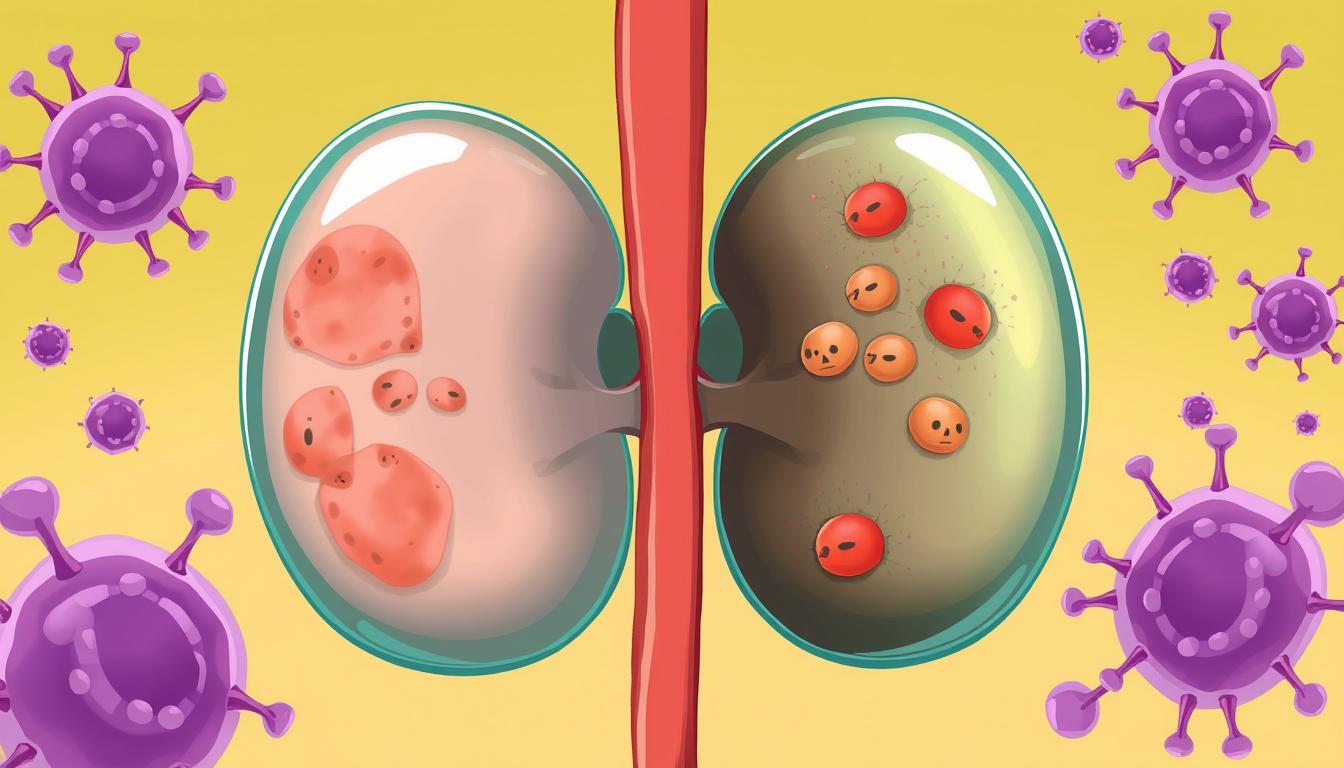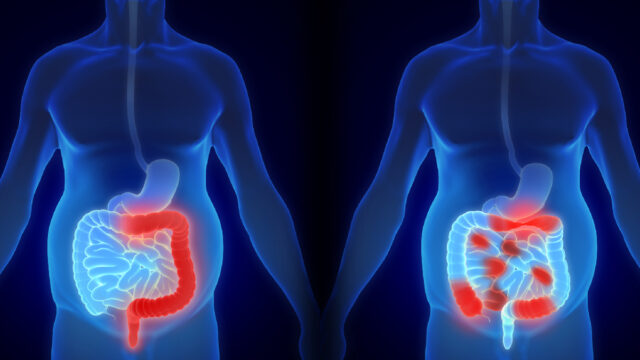FTC disclaimer: This post may contains affiliate links and we will be compensated if you click on a link and make a purchase.
Bladder cancer is a common cancer that affects about 80,000 Americans each year. It’s worrying because it often comes back after treatment, happening in 75% of early cases. Knowing the signs and treatment options is key to fighting this serious disease.
Bladder cancer starts in the bladder’s lining. It can happen to anyone, but some are at higher risk. This includes smokers, people over 55, and men, who are four times more likely to get it than women. Other risks include exposure to harmful chemicals, past cancer treatments, and a family history of the disease.
The first sign of bladder cancer is often blood in the urine. Other signs include changes in how often you pee, pain or burning, and a weak stream. These symptoms can also mean other issues, so seeing a doctor is important for the right diagnosis and treatment.
Key Takeaways
- Bladder cancer is a relatively common form of cancer that starts in the lining of the bladder.
- Certain groups, such as smokers, older adults, and men, face a higher risk of developing bladder cancer.
- The most common early symptom of bladder cancer is blood in the urine, which may come and go.
- Bladder cancer can be effectively treated, but regular follow-up and monitoring are essential as the disease has a high recurrence rate.
- Consulting a healthcare provider is crucial if bladder cancer is suspected, as prompt diagnosis and treatment are key to managing the disease.
What is Bladder Cancer?
Definition and Types
Bladder cancer starts in the bladder’s lining. The bladder is a triangle-shaped organ for urine storage. There are several types, with transitional cell carcinoma being the most common, making up about 90% of cases.
Squamous cell carcinoma can form after irritation or infection. Adenocarcinoma starts in glandular cells, and small cell carcinoma begins in neuroendocrine cells. Sarcomas, from muscle cells, are very rare.
Bladder cancer can be non-muscle-invasive or muscle-invasive. Non-muscle-invasive is easier to treat. Muscle-invasive is harder.
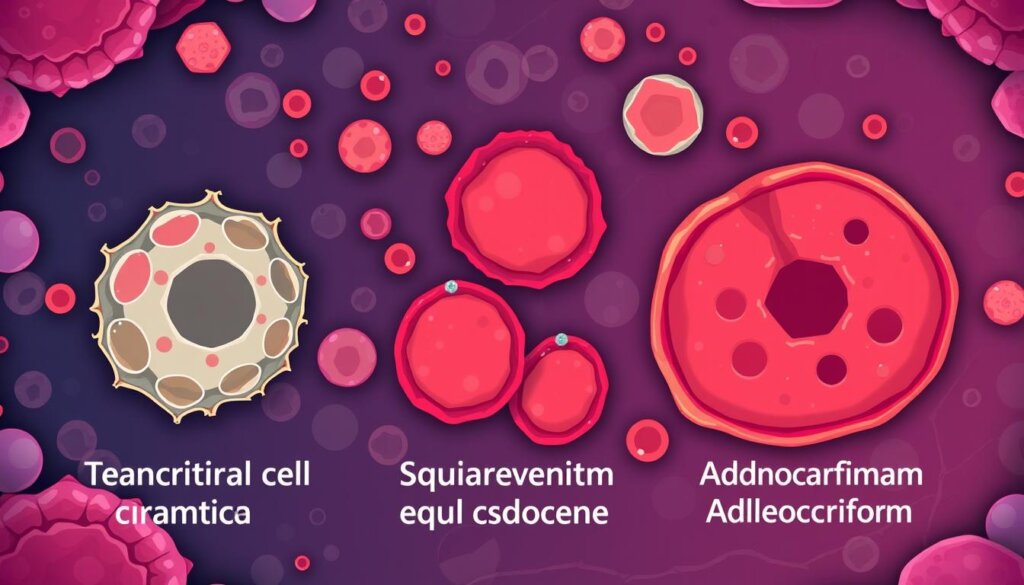
Smoking is a big risk for bladder cancer. Knowing about bladder cancer types is key for early detection and treatment.
“The bladder can hold up to 1 pint (16 ounces) of urine at a time and contracts or expands based on the fluid volume inside.”
The kidneys filter 20% of blood each minute, and the bladder is vital for urine storage and release. Spotting bladder cancer signs and getting medical help quickly can improve treatment chances.
Risk Factors for Bladder Cancer
Bladder cancer is a serious condition. Knowing the risk factors is key for prevention and early detection. Some risk factors are beyond our control, but being aware helps us take steps to lower our risk.
Smoking is a big risk factor for bladder cancer. Smokers are 3 times more likely to get bladder cancer than non-smokers. About half of all bladder cancer cases are linked to smoking. Also, working with certain chemicals can raise the risk of bladder cancer.
Age is another risk factor, with bladder cancer more common in older adults. Around 9 out of 10 bladder cancer cases are in people over 55. Men are more likely to get bladder cancer than women.
Family history and genetics also play a role. Some genetic changes, like HRAS and RB1 gene mutations, increase the risk. Having a relative with bladder cancer also raises your risk.
Other risk factors include previous cancer treatments and chronic bladder inflammation. Exposure to chemicals like arsenic or chlorine in water also increases the risk. It is important to talk to a healthcare provider about these risks.

Understanding bladder cancer risk factors helps us take action. Regular check-ups and a healthy lifestyle are key. Talking to a healthcare provider about risk factors is also crucial.
Signs and Symptoms
Early Warning Signs
The most common early symptom of bladder cancer is blood in the urine, known as hematuria. This may make the urine look orange, pink, or dark red. It might not be seen but found in a urine test. Other early signs include changes in bladder habits, like more frequent urination, painful urination, or a weak urine stream.
As the cancer gets worse, more symptoms appear. These include not being able to urinate, lower back pain, loss of appetite, weight loss, fatigue, and bone pain. Remembering these symptoms can also mean other, less serious issues is key.
Bladder cancer hits about 80,000 people in the U.S. each year. It’s the fourth most common cancer in men and eighth in women. Smokers are 4 to 7 times more likely to get bladder cancer than non-smokers. Men are four times more likely to get it than women. The average age at diagnosis is 73.
For non-muscle invasive bladder cancer, the five-year survival rate is over 92% with the right treatment. But, as the disease stage gets worse, the five-year survival rate for muscle-invasive bladder cancer drops. It’s 85% when treated with surgery just to the bladder.
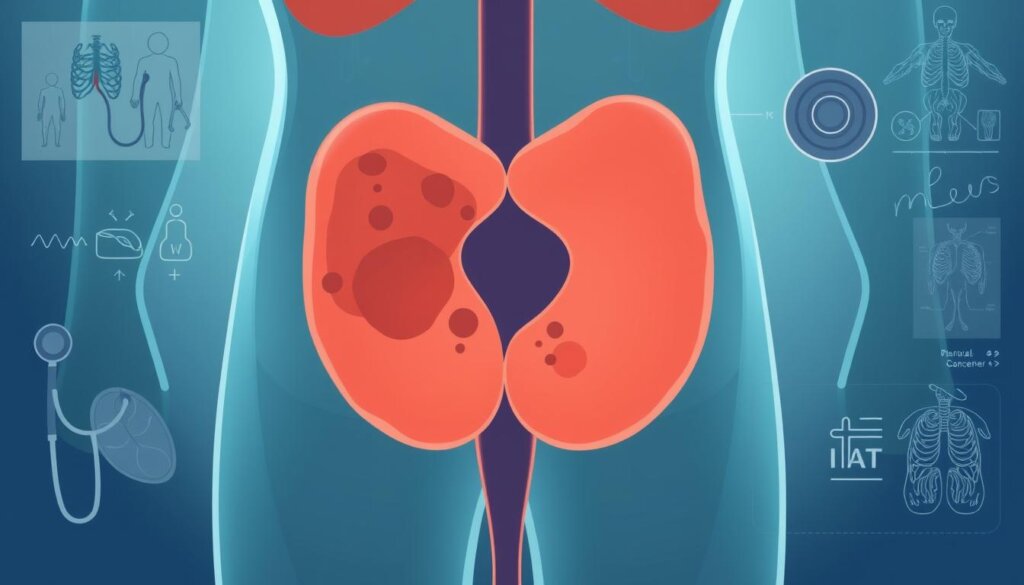
Bladder cancer can hit women and younger people, though it’s more common in older men. Women might find it hard to tell bladder cancer symptoms from other urinary issues. They might think blood in the urine is just a UTI or postmenopausal bleeding. This can lead to a late diagnosis, making treatment harder.
Other symptoms of bladder cancer include pain or burning while urinating, needing to urinate even when the bladder isn’t full, frequent trips to the toilet, and nocturia (urinating at night). Fatigue, flank pain, loss of appetite, and weight loss are also common in bladder cancer and other cancers.
“Early detection of bladder cancer symptoms is crucial for successful treatment and improved patient outcomes.”
If you notice any of these symptoms, see your healthcare provider right away. Early detection can greatly improve treatment chances and outcomes for bladder cancer patients.
Bladder Cancer Diagnosis
Diagnosing bladder cancer often starts with a cystoscopy. This is when a doctor uses a small camera to look inside the bladder and urethra. It helps find any areas that might need more tests like a biopsy to check cells or tissue under a microscope.
Imaging tests, like a CT urogram or retrograde pyelogram, are also important. These tests use dye to make detailed pictures of the kidneys, bladder, and ureters, helping to find problems in the urinary tract.
Diagnostic Tests
Other tools are used too, like:
- Urine cytology: This test looks at urine under a microscope for cancer cells.
- Urine tumor marker tests check for substances in urine that bladder cancer cells make or that the body responds to.
- Transurethral resection of bladder tumor (TURBT): This is a small procedure to remove bladder tumors for testing.
By using these tests together, doctors can determine the kind and stage of bladder cancer, which is key to making a good treatment plan.
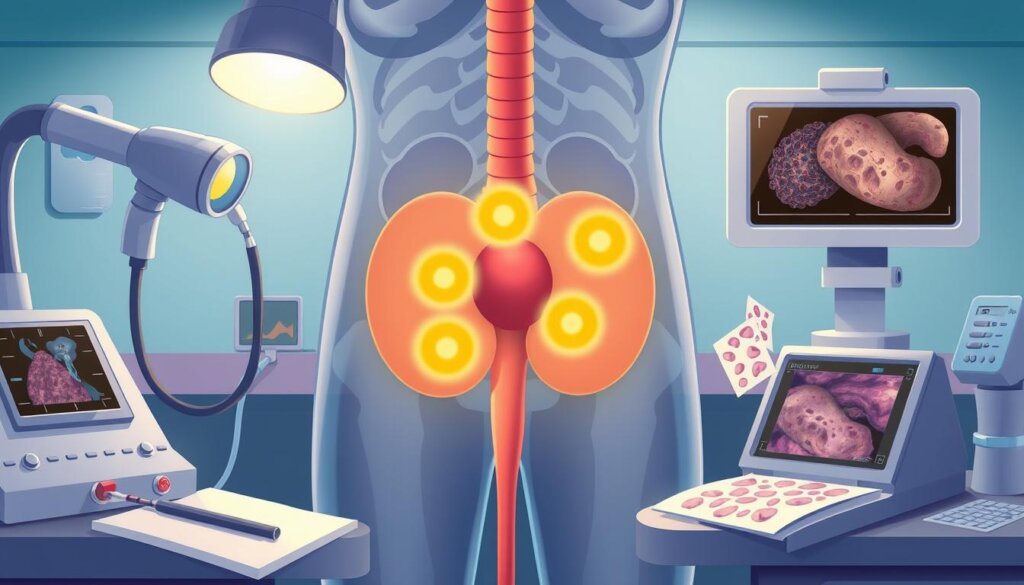
Diagnostic Test | Description | Key Findings |
|---|---|---|
Cystoscopy | A procedure where a doctor uses a small camera to examine the inside of the bladder and urethra. | Helps detect suspicious areas and guide further testing, such as a biopsy. |
CT Urogram | An imaging test that uses contrast dye to create detailed pictures of the kidneys, bladder, and ureters. | Identifies abnormalities in the urinary tract. |
Urine Cytology | A non-invasive test that examines a urine sample under a microscope to check for cancer cells. | Helps detect the presence of bladder cancer cells. |
Urine Tumor Markers | Tests that analyze substances in the urine related to bladder cancer. | Aids in identifying certain types of bladder cancer. |
TURBT | A minimally invasive procedure to remove visible tumors in the bladder for further testing. | Allows for the removal and analysis of any tumors. |
Doctors can use these tests together to determine the type and stage of bladder cancer, which is very important for making a good treatment plan.
Treatment Options for Bladder Cancer
Doctors look at many things when treating bladder cancer. They consider the cancer’s type and stage, as well as the patient’s health and wishes. The main treatments are surgery, chemotherapy, radiation, targeted therapy, and immunotherapy.
Surgery is often the first step. Doctors might do a transurethral resection, partial cystectomy, or radical cystectomy. Before surgery, chemotherapy might be used to shrink the tumor. After surgery, they might use chemotherapy, radiation, immunotherapy, or targeted therapy.
Radiation therapy is another choice. External beam radiation therapy is common. Chemotherapy drugs like carboplatin and cisplatin help kill cancer cells.
Immunotherapy drugs help the body fight cancer. Drugs like atezolizumab and pembrolizumab are used. Intravesical immunotherapy with BCG is also an option.
Targeted therapy drugs aim at cancer’s weaknesses. Drugs like Enfortumab vedotin are used for this.
Some patients might join clinical trials for new treatments. Tests after treatment help see if the therapies work.
The right treatment plan varies by person. Many get a mix of therapies for the best results.
Treatment Option | Description |
|---|---|
Surgery | Transurethral resection, partial cystectomy, radical cystectomy |
Chemotherapy | Carboplatin, cisplatin, doxorubicin, gemcitabine |
Radiation Therapy | External beam radiation therapy |
Immunotherapy | Atezolizumab, avelumab, nivolumab, pembrolizumab, BCG, nadofaragene firadenovec-vncg, nogapendekin alfa inbakicept-pmln |
Targeted Therapy | Enfortumab vedotin, erdafitinib, ramucirumab, sacituzumab govitecan-hziy |
“Treatment for bladder cancer can be complex, but advancements in medical research have provided patients with more options than ever before. Working closely with your healthcare team to develop a personalized treatment plan is crucial for achieving the best possible outcome.”
Bladder Cancer Stages
Bladder cancer is staged based on how far the cancer has grown into the bladder wall and whether it has spread to other parts of the body. The staging system for bladder cancer is key in picking the right treatment and knowing how well it will work.
Bladder cancer stages range from 0 (non-invasive) to IV (advanced). The American Joint Committee on Cancer (AJCC) TNM system is used. It looks at three things: T for tumor growth, N for lymph node involvement, and M for metastasis.
Stage 0 bladder cancer is non-invasive. Stage I is non-muscle-invasive, and Stage II is muscle-invasive. Stage III and IV show cancer has spread further.
Bladder cancer is also grouped into risk levels. Non-muscle invasive (NMIBC) and muscle-invasive bladder cancer (MIBC) have different treatments. NMIBC is split into low, intermediate, and high-risk groups. Knowing the stage and risk helps predict cancer’s spread and treatment success.
About 10% of bladder cancer patients have Carcinoma in situ (CIS). Most bladder cancers start in the bladder, but can also be found in the kidney and ureter. Tumors are staged from T0 (No tumor) to T4 (Tumor invades other organs). Pathologists look at tissue samples to find the stage and grade of bladder cancer.
“Understanding the staging and risk groups of bladder cancer is crucial for treatment planning and predicting the course of the disease.”
Follow-up and Monitoring
Bladder cancer needs constant watchfulness, even after treatment. People who have had bladder cancer are at risk for it coming back. They should get follow-up tests every 3 to 6 months.
Those without signs of cancer after treatment need regular cystoscopy exams. This is especially true for the first couple of years.
It’s key to keep an eye out for bladder cancer coming back. Survivors with a urinary diversion should check for infection and kidney health at least once a year. Smoking and being overweight can also raise the risk of cancer coming back.
No special diet has been proven to stop bladder cancer from coming back. People who had bladder cancer are also at higher risk for other cancers.
Keeping up with follow-up and monitoring is crucial for bladder cancer survivors. The cost of watching for bladder cancer in older adults has been studied. Too much use of cystoscopy in low-risk cases has been found.
Researchers have looked at long-term outcomes for certain bladder cancers. They’ve also studied how often bladder cancer comes back in low-risk cases.
The need for follow-up cystoscopy after five years has been discussed. Rates of late recurrence and progression have been noted. Different ways of checking for bladder cancer have been compared.
Regular follow-up and monitoring are key for bladder cancer survivors. By staying alert and following guidelines, people can catch any new cancers early. This can greatly improve their health outcomes.
Coping and Support
Getting a bladder cancer diagnosis is tough and can feel overwhelming. But, there are ways to cope and stay healthy. Eating well, exercising, and sleeping enough helps your body during treatment.
Being part of a support group can make you feel less alone. You can share your story and learn from others who face the same challenges. Doctors can also suggest ways to handle the emotional side of treatment.
Lifestyle Changes and Support Groups
- Start a healthy routine with good food, exercise, and enough sleep to help your body during treatment.
- Join support groups, online or in person, to meet others who get what you’re going through.
- Use mental health resources like counseling to deal with the emotional side of your diagnosis and treatment.
- Talk openly with your doctors, ask questions, and stay updated on your treatment plan.
“Coping with the fear of cancer recurrence is a common challenge for individuals treated for bladder cancer.”
By making lifestyle changes and getting support, bladder cancer patients can feel better physically and emotionally. This improves their life quality during and after treatment.
Bladder Cancer Statistics
Bladder cancer is the fourth most common cancer in men and people designated male at birth (DMAB) in the U.S. Men and DMAB individuals are four times more likely to get it than women and people designated female at birth (DFAB). It usually hits older adults, with an average age of 73 at diagnosis. Knowing about the disease and its symptoms is key for early detection and treatment.
Bladder cancer makes up 4.2% of all new cancer cases in the U.S. In 2024, it’s expected to have 83,190 new cases and 16,840 deaths. The rate of new cases was 18.2 per 100,000 men and women yearly from 2017-2021. The death rate was 4.1 per 100,000 yearly from 2018-2022.
White men and DMAB individuals are twice as likely to get bladder cancer as Black people. About 2.2% of men and women will get bladder cancer at some point. In 2021, there were 730,044 people living with it in the U.S..
Bladder cancer has a 5-year survival rate of 78.4% from 2014 to 2020. It’s the tenth leading cause of cancer death in the U.S.. But, rates of new cases and deaths have been dropping. They’ve gone down by 1.0% and 0.9% yearly, respectively.
Bladder Cancer Statistics | Global | United States |
|---|---|---|
Incidence (new cases) | 614,298 (2022) | 83,190 (estimated for 2024) |
Mortality (deaths) | Not available | 16,840 (estimated for 2024) |
Ranking by Incidence | 9th most common cancer worldwide | 4th most common cancer in men |
5-Year Relative Survival | Not available | 78.4% (2014-2020) |
While bladder cancer is rare, it’s vital for people, especially those at high risk, to know about it. The latest statistics help us understand the disease better. They guide us in preventing, detecting, and treating it.
“Survival statistics cannot be used to predict individual outcomes due to variations in responses to treatment and the effects of newer treatments not yet reflected in the data.”
It’s important to remember that while the stats give a general view, individual experiences can differ. This is because of how people react to treatment and the impact of new therapies.
Conclusion
Bladder cancer is a serious but treatable disease. It mainly affects the bladder’s lining. Some groups, like smokers and older adults, are at higher risk. Knowing the signs and treatment options helps protect your urinary health.
Regular doctor visits and quick action for symptoms like blood in urine are key. Following cancer screening advice can lead to better detection and treatment. New treatments like targeted and immunotherapies offer hope and better life quality for patients.
Stay alert, live healthily, and work with your healthcare team. This way, you can face bladder cancer with confidence. Research and new treatments promise better prevention, detection, and treatment for all.
FAQ
What is bladder cancer?
Bladder cancer starts in the bladder’s lining. It’s a triangle-shaped organ that holds urine. The most common type is transitional cell carcinoma, making up about 90% of cases.
What are the risk factors for bladder cancer?
Big risk factors include smoking and being over 55. Being male and exposed to certain chemicals also increase risk. Previous cancer treatments, chronic bladder inflammation, and family history play a role too.
What are the early symptoms of bladder cancer?
Early signs often include blood in the urine, or hematuria. You might also notice changes in how often you urinate or if it hurts. A weak urine stream is another symptom.
How is bladder cancer diagnosed?
Doctors use tests like cystoscopy and urine cytology to find bladder cancer. Imaging scans like CT urogram or retrograde pyelogram are also used.
What are the treatment options for bladder cancer?
Treatments include surgery, chemotherapy, and radiation therapy. Targeted drug therapy and immunotherapy are options too. The best plan depends on the cancer’s type and stage, and the patient’s health.
How are bladder cancers staged?
Staging shows how far the cancer has grown and if it’s spread. Stages range from noninvasive to muscle-invasive bladder cancer.
What happens after bladder cancer treatment?
Even with treatment, bladder cancer can come back. Regular check-ups and tests are key to catching any signs of recurrence early.
How can bladder cancer patients cope and support their well-being?
Patients can stay healthy and join support groups. Mental health resources can help manage the emotional side of diagnosis and treatment.
Who is most affected by bladder cancer?
Men and people designated male at birth are most affected. They are four times more likely to get bladder cancer than women and people designated female at birth.
